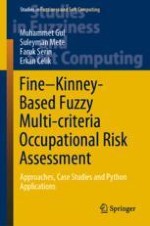
2021 | OriginalPaper | Chapter
1. Fine–Kinney Occupational Risk Assessment Method and Its Extensions by Fuzzy Sets: A State-of-the-Art Review
Authors : Assoc. Prof. Muhammet Gul, Assoc. Prof. Suleyman Mete, Assist. Prof. Faruk Serin, Assoc. Prof. Erkan Celik
Published in: Fine–Kinney-Based Fuzzy Multi-criteria Occupational Risk Assessment
Publisher: Springer International Publishing
Activate our intelligent search to find suitable subject content or patents.
Select sections of text to find matching patents with Artificial Intelligence. powered by
Select sections of text to find additional relevant content using AI-assisted search. powered by